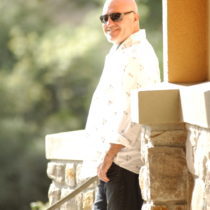Landscape Architecture for Landscape Architects › Forums › DETAILS & MATERIALS › Artificial rock work as a design medium (#3 of 10)
- This topic has 0 replies, 1 voice, and was last updated 15 years, 5 months ago by
 Matthew E Wilson.
Matthew E Wilson.
-
AuthorPosts
-
November 17, 2008 at 4:36 pm #176099
 Matthew E WilsonParticipant
Matthew E WilsonParticipantTypes of artificial rock (article #3 0f 10)
The two most predominate types of artificial rock are hand carved and cast as mentioned earlier. In the previous section we spoke of the hand carved technique of pneumatically applying cementious material over a structurally sound shape and texturing, carving, & coloring. This method relies on the ability of the craftsmen and artisans to sculpt in a very narrow window of time all of the complexities and creativity that makes up what we recognize as rock. Everyone these days has witnessed some really awful hand carved rockwork particularly at miniature golf courses or low budget residential properties. Most of these types of features are by well meaning trade’s people without the benefit of any real training or skill set to tackle such a project in the first place. Monkey see monkey do seems to be the prototypical model for their artistry which falls horribly short of expectations and taints the industry as a whole. I would have to admit that even I have produced some terrible examples during my early learning curve and like everything with practice comes perfection. I would admit that it takes a certain amount of passion and dedication to be honest enough with yourself to realize your weaknesses and your strengths as it relates to ones artistic abilities to replicate natural looking habitats. Whether to pursue this endeavor and strive to become the best in your area of expertise or not is a question for everyone considering this talent. To simply stay in artificial rockwork or to bid the odd project that comes along to supplement your other functions is just wrong if your talent does not permit at least a level of competence so as to not embarrass your self or the industry as a whole.
The great equalizer in artificial rockwork fabrication is the second method described as cast rockwork. In the cast method of fabrication a glass fiber reinforced concrete panel(s) or boulder cap(s) covers a rebar armature for future grouting (grouting: filling the hollow void with solid concrete mixture) or can be laminated over the surface of an existing solid concrete shape to provided an exacting rock surface texture. These gfrc casting average ¾” to 1” inch in thickness and the dimensions can vary wildly but typically are about 4’ x 5’ feet of smaller. It is an exact copy of real rock, or other product as mentioned previously, and when correctly designed, seamed (seamed: hand texturing in between gfrc cast panels with a plaster composite mixture.) and colored will create an artistic piece of unbelievable proportions. The molds have a very long life span and castings can be turned out by the hundreds. In fact two exact casting can be flipped upside down from each other without anyone detecting the similarity.
Next article
Reasons for hand carved rock
Quote
“Everyone has music in them. Only the talented have the ability to share it with the rest of the world”
-
AuthorPosts
- You must be logged in to reply to this topic.

